
The Zombies are an English rock band formed in St Albans in 1961. Led by keyboardist/vocalist Rod Argent and vocalist Colin Blunstone, the group had their first British and American hit in 1964 with "She's Not There". In the US, two further singles—"Tell Her No" in 1965 and "Time of the Season" in 1968—were also successful.

My Generation is the debut studio album by English rock band the Who, released on 3 December 1965 by Brunswick Records in the United Kingdom, and Festival Records in Australia. In the United States, it was released on 25 April 1966 by Decca Records as The Who Sings My Generation, with a different cover and a slightly altered track listing. Besides the members of the Who, being Roger Daltrey (vocals), Pete Townshend (guitar), John Entwistle (bass) and Keith Moon (drums), the album features contributions by session musician Nicky Hopkins (piano).

Screamadelica is the third studio album by Scottish rock band Primal Scream. It was first released on 23 September 1991 in the United Kingdom by Creation Records and on 8 October 1991 in the United States by Sire Records. The album marked a significant departure from the band's early indie rock sound, drawing inspiration from the blossoming house music scene and associated drugs such as LSD and MDMA. Much of the album's production was handled by acid house DJ Andrew Weatherall and engineer Hugo Nicolson, who remixed original recordings made by the band into dance-oriented tracks.

Rodney Terence Argent is an English musician. In a career spanning more than 50 years, Argent came to prominence in the mid-1960s as the keyboardist, founder and leader of the rock band the Zombies, and went on to form the band Argent after the first break-up of the Zombies.

In the Court of the Crimson King is the debut studio album by English progressive rock band King Crimson, released on 10 October 1969 by Island Records. The album is one of the earliest and most influential of the progressive rock genre, where the band combined the musical influences that rock music was founded upon with elements of jazz, classical, and symphonic music.

Red is the seventh studio album by English progressive rock band King Crimson. It was released in October 1974 on the Island Records label in the United Kingdom, and Atlantic Records in North America and Japan. The album was recorded at Olympic Studios in London in July and August 1974, and produced by the band themselves. The track "Providence" was a free improvisation recorded at their 30 June 1974 concert at the Palace Theater in Providence, Rhode Island. Parts of some of the pieces were conceived during previous improvisations performed by the band live. "Starless" was originally written for their previous album, Starless and Bible Black (1974), but was considered too primitive to be released at the time. The lengthy version included on Red was refined and performed during concerts throughout 1974.

Colin Edward Michael Blunstone is an English singer and songwriter. In a career spanning more than 60 years, Blunstone came to prominence in the mid-1960s as the lead singer of the rock band the Zombies, which released four singles that entered the Top 75 charts in the United States during the 1960s: "She's Not There", "Tell Her No", "She's Coming Home" and "Time of the Season". Blunstone began his solo career in 1969, releasing three singles under a pseudonym of Neil MacArthur. Since then, he has released ten studio albums under his real name. He appears on several albums with the Alan Parsons Project and sang "Old and Wise".

"Time of the Season" is a song by the British rock band the Zombies, featured on their 1968 album Odessey and Oracle. It was written by keyboard player Rod Argent and recorded at Abbey Road Studios in September 1967. Over a year after its original release, the track became a surprise hit in the United States, rising to number three on the Billboard Hot 100 and number one on the Cashbox chart. It has become one of the Zombies' most popular and recognizable songs, and an iconic hit of 1960s psychedelia.

Cheap Thrills is the second studio album by American rock band Big Brother and the Holding Company, issued by Columbia Records in 1968. Cheap Thrills was the band's final album with lead singer Janis Joplin before she left to begin a solo career. For Cheap Thrills, the band and producer John Simon incorporated recordings of crowd noises to give the impression of a live album, for which it was subsequently mistaken by many listeners. Only "Ball and Chain" was actually recorded in concert at the Winterland Ballroom.

"I Can See for Miles" is a song by the English rock band the Who, recorded for the band's 1967 album The Who Sell Out. Written by guitarist Pete Townshend, it was the only song from the album to be released as a single.
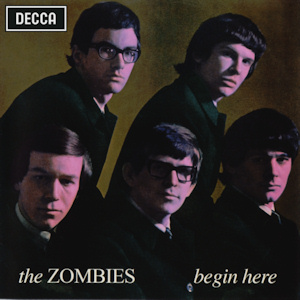
Begin Here is the debut studio album by the English rock band the Zombies, released in April 1965 by Decca Records. The American version repeated many of the tracks from it, but, as was common at the time, deleted some and substituted others.
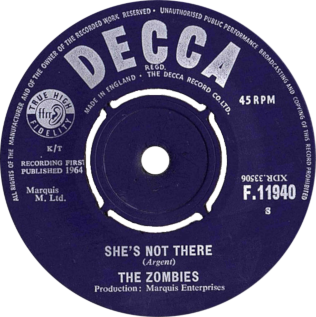
"She's Not There" is the debut single by British rock band the Zombies, written by keyboardist Rod Argent. It reached No. 12 in the UK Singles Chart in September 1964, and No. 2 on the Billboard Hot 100 in the United States at the beginning of December 1964. In Canada, it reached No. 2.

Christopher Taylor White is an English musician. He came to prominence in the mid-1960s as the bass guitarist and occasional lead vocalist of the rock band The Zombies. White is one of the main composers of the Zombies' music, and made major lyrical contributions to the band's songs. He was inducted into the Rock and Roll Hall of Fame in 2019 as a member of the Zombies.
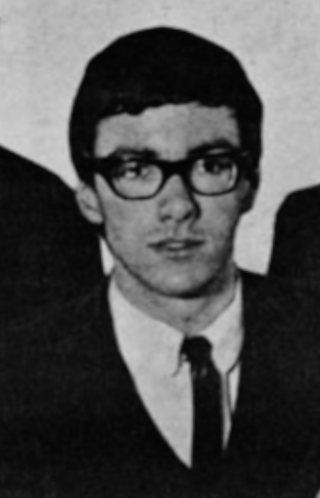
Paul Ashley Warren Atkinson was a British guitarist and record company executive, best known as a founding member of the pop/rock band The Zombies. Atkinson was posthumously inducted into the Rock and Roll Hall of Fame in 2019.
Hugh Birch Grundy is an English musician. In a career spanning more than 50 years, Grundy came to prominence in the mid 1960s as the drummer of the English rock band the Zombies. He was inducted into the Rock and Roll Hall of Fame in 2019.
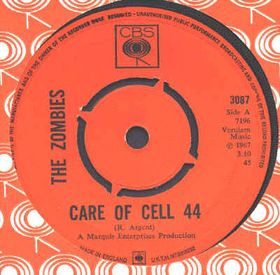
"Care of Cell 44" is a single by the Zombies, released as the lead single from their album Odessey and Oracle in November 1967. It was featured on Pitchfork's "200 Best Songs of the 1960s" list, and has been covered by modern artists including Elliott Smith and Of Montreal.

"Butcher's Tale " is a song written by Chris White of the Zombies, first released on the group's 1968 album Odessey and Oracle. It was also released as a single in the United States in June 1968, backed by "This Will Be Our Year." "Butcher's Tale" was recorded in one take on 20 July 1967 at EMI Abbey Road Studio No. 3. The song has also been covered by They Might Be Giants, The Immediate, John Wilkes Booze and Chrysanthemums. The anti-war protest song is written from the perspective of a soldier fighting on the Western Front of World War I, mentioning the battles at Gommecourt, Thiepval, Mametz and Verdun in France.

Time of the Zombies was a U.S.-only 1974 two-LP compilation album of music by the British band, The Zombies. It contained hits, non-album singles, previously unreleased tracks intended for a planned posthumous album named R.I.P. which was not released until 2000, and the whole of their April 1968 album, Odessey and Oracle. It was released on Epic Records in 1974, several years after the group had disbanded.

Still Got That Hunger is the sixth studio album by English rock band the Zombies, released on 9 October 2015. The band funded production of the album through the crowdfunding web site PledgeMusic, receiving donations from 958 pledgers and reaching 143% of its funding goal.
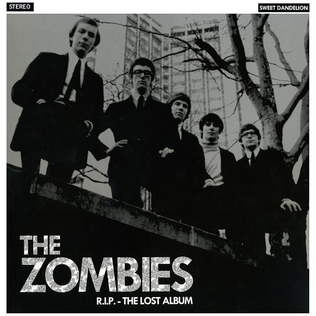
R.I.P., also known as R.I.P. - The Lost Album, is a studio album by English rock band the Zombies. It was originally scheduled to be released in 1969, but was cancelled. It was first released in Japan in October 2000 by Imperial Records.



















